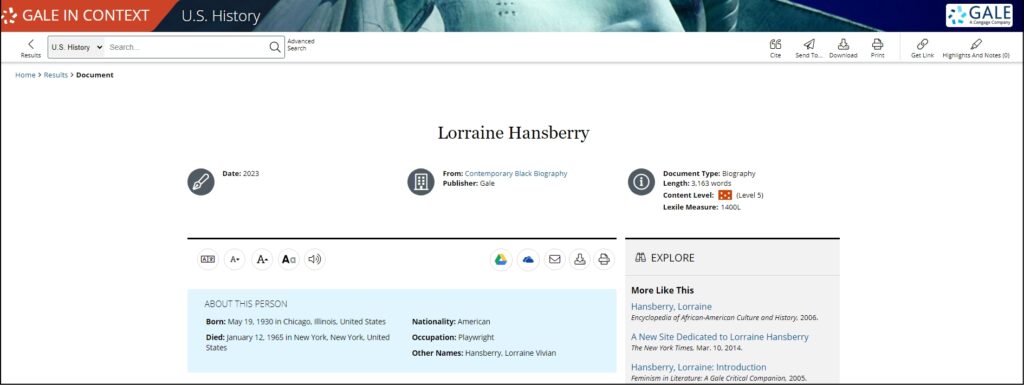| By J. Robert Parks |
A Raisin in the Sun was one of the most significant American plays of the twentieth century. Written by Lorraine Hansberry, it portrays a multigenerational, working-class Black family living in a cramped home in Chicago, Illinois, but dreaming of something more. It received its Broadway premiere 65 years ago this week, on March 11, 1959, and was the first play written by a Black woman to be produced on Broadway. Librarians and educators looking to help students understand the background of the play and its significance, as well as the tragically short life of Lorraine Hansberry, will find numerous resources in Gale In Context: U.S. History.
Hansberry was born in Chicago in 1930 and grew up on the South Side. Her home was a center for Black intellectuals and artists, with visitors including singer Paul Robeson and civil rights activist, sociologist, and writer W. E. B. Du Bois. After attending the University of Wisconsin for two years, Hansberry moved to New York City, where she took classes; wrote for Robeson’s magazine, Freedom; and grew progressively more involved in political activism. Her politics were radical for their time and focused on transforming U.S. society to make it more just and free for people of color and women. Although Hansberry married in 1953, she identified as a lesbian—a fact that became more widely known after 2013, when some of her private writings finally became available to researchers.

Written in 1957, A Raisin in the Sun was Hansberry’s first produced play, and its title comes from the Langston Hughes poem “Harlem.” The story focuses on the Younger family, who all live in a small apartment. The matriarch, Lena (known as Mama), has just received money from a life insurance policy after the death of her husband, and the members of the family each have different dreams for how the money might be used. Beneatha, Mama’s daughter, wants to go to school to become a doctor. Mama and her daughter-in-law, Ruth, hope to buy a larger home away from the depressed neighborhood where they now live. Walter Lee, Mama’s son and Ruth’s husband, wants to use the money to start a business. An interesting analysis of the play suggests that A Raisin in the Sun portrays the conflict between various worldviews common to Black Americans in the modern era.
Certainly, one of the play’s primary themes is racism—especially the racism that Black people have historically faced in trying to buy a home. Hansberry knew that difficulty personally, as her parents were part of an important Supreme Court case, Hansberry v. Lee, in which they had been barred from buying a home in an all-white neighborhood solely because they were Black. The same circumstance arises in the latter scenes of A Raisin in the Sun. Gale In Context: U.S. History can help people understand the historical events and themes that authors incorporate in works of literature.
Broadway, the center of U.S. theatrical life, was also a bastion of the racism and sexism of the mid-twentieth century. Not only was Hansberry the first Black woman to have a play produced on Broadway, but she was the first Black writer and only the fifth woman to have her play win the New York Drama Critics’ Circle Award for best play of the year. A Raisin in the Sun has been justly celebrated ever since its premiere. The original production featured a cast of some of the finest actors of their time. Sidney Poitier played Walter Lee, Ruby Dee played Ruth, and Louis Gossett Jr. played one of Beneatha’s suitors.
A Raisin in the Sun may be 65 years old, but it still feels relevant and urgent today—both in its portrayal of the struggles of the working poor and the challenges Black people face in a society where racism is still prevalent. Such is one of the great things that literature can accomplish: help us understand the experiences of others. As for Hansberry, she died at the tragically young age of 34 from pancreatic cancer. Nonetheless, her ideas persist in the characters, dialogue, and stage direction that she conceived for the groundbreaking dramatic work.
About the Author
J. Robert Parks is a former professor and frequent contributor to Gale In Context: U.S. History and Gale In Context: World History who enjoys thinking about how our understanding of history affects and reflects contemporary culture.



